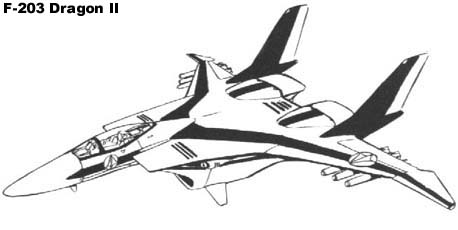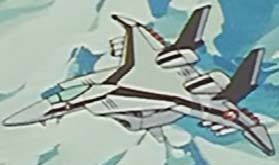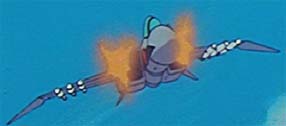

The McDonnell Douglas F-203 Dragon-II is an air-dominance fighter built for the United States armed forces during the global civil war of the 1990ís to replace the aging F-15 fighter. In 1990, the United States Advanced Tactical Fighter program was to select a front-line fighter to succeed the F-15 through a competition between Lockheed/Boeing/General Dynamics YF-22 and the Northrop/McDonnell Douglas YF-22; however, with the start of the Global Civil War in 1992 both designs were still years away from operational status. The design team at McDonnell Douglass proposed the F-203 Dragon II as an interim solution. The F-203 would have many of the advanced aerodynamic properties of the YF-22, but would lack the advanced stealth and electronics that still needed years of development. First flight took place on March 21, 1992 with the first combat squadrons forming with the USAF only eight months later.
The early model F-203 fighters make extensive use of carbon composites to reduce weight and reduce the passive radar cross section of the aircraft. However titanium, or titanium alloys, still makes up a large percentage of the structural material (38%) and makes up large portions of the fuselage, keel, and aft booms that hold the horizontal and vertical stabilizers. Each wing is made of carbon-fiber/Bismaleimide (BMI) which is stronger than traditional thermoplastic-matrix composites. However, the maximum speed of the unit is reduced from Mach 2.4 to 2.6 because BMI can not tolerate temperatures as high as conventional composites
The fuselage layout consists of a central structure flanked by two engine bays; this large volume contains the primary internal fuel for the F-203 with an internal capacity of over 7,800 liters of fuel for the -A model. Two intakes lead aft and toward the centerline in an S-curve to feed the engines mounted in a side-by-side configuration between the tails. Two Pratt & Whitney F122 two-spool, low-bypass turbo fans with contra-rotating high and low pressure turbines with vectoring nozzles power the F-203 A/B. The F-203 vectoring nozzles are effective in enhancing the Dragonís high angle-of-attack maneuverability with the unit capable of greater than 60-deg angles of attack at altitudes up to 60 kft.
Flight control is provided through a Fly-By-Wire (FBW) system and is a principal element in the wide flight envelope open to the F-203. Although hard to document, Western Coalition pilotís claimed during the war that they could try nearly any maneuver without losing control. The sensor system on the F-203 was the most advanced for the time consisting of a Raytheon APG-72 multi-mode Electronically Scanned Array (ESA) radar. The system is capable of detecting a fighter-sized target (0 dBsm) out to 100 kilometers while minimizing emissions. The APG-77 can function as a synthetic aperture radar providing target quality coordinates to onboard air-to-ground weapons or other platforms.
Unlike the F-22, the F-203 does not have any internal weapons bay and therefore carries weapons on ten externally mounted hardpoints, three under each wing and four under the fuselage. Use of these external hardpoints raises the passive radar cross section of the F-203 when used. Each of the pylons can mount a single AIM-9X or AMRAMM missile or up to 500 kg of ordinance. Targets are displayed either on a conventional cockpit HUD or inside the pilotís helmet. Rounding out the armament for the Dragon-II are two M6A2 20mm six barrel cannons over the right and left engine inlets. The cannons are fed through two double-ended hydraulically driven linkless feed systems from a single internal ammunition drum holding 1200 rounds.
A total of 2,250 F-203A were built for the USAF and an additional 450 were built under license for other members of the Western Alliance from 1992 until 1996. The -A model was capable of out flying all contemporary Eastern Co-Prosperity Sphere (ECPS) fighters including the MIG-31 racking up an impressive 10 to1 ratio in kills. A total of 172 F-203A fighters were destroyed in air-to-air combat; however, 374 were killed by surface to air missiles. Production of -A model ended in 1996 with the introduction of the -C model outfitted with the ALE-50 towed decoy to help minimize the effectiveness of RF guided SAMs. Although production stopped in 1996, fighters were desperately needed for the global conflict and -A fighters were used throughout the duration of the conflict. The final -A models were finally retired in 2009 from the UNDF.
F-203B
In March 1992, two months after the opening shots of the Global Civil War, the United States Navy needed to find a new aircraft to replace the F-14. As the F-203 was already in pre-production for the USAF, the USN requested a navalized version of the F-203 airframe later designated as the F-203B. A total of 650 units were produced exclusively for the USN from 1992 until production was switch to the -D model in 1996.
The F-203B shares nearly 95% common components with the USAF ĖA model; however there are a couple of noticeable modifications. First, the fuselage was extended by five feet to allow the inclusion of a twin seat cockpit. The second position in the rear of the pilot would be manned by a Weapon Systems Officer, WSO. The extended cockpit extends back into the primary internal fuel tanks reducing their capacity by nearly 800 liters. The airframe and landing gear were strengthened and a tail hook was added to allow the F-203 to operate off of carriers. The added structure, however, increases the weight of the aircraft by nearly 400 kg, which makes the navalized version slightly less maneuverable than the ĖA model and coupled with the reduction of the internal fuel supply reduces the combat radius by nearly 400 km.
F-203C/D
Four years after the introduction of the F-203 A/B, an upgraded version of both the air force and naval version of the Dragon-II was first proposed and four months later entered into production. The F-203C was a single seat fighter designed for the USAF to replaced the -A and the F203D would be a two seater for the USN to replace the earlier -B model. Both versions were designed around the P&W F114 turbo fan engines producing 5% additional thrust while improving fuel efficiency over the older F112 models. Although, a majority of the electronics and all of the weapon systems were retained from the earlier design, the -C/D models was outfitted with the ALE-50 RF towed decoy. The ALE-50 decoy provides protection against RF surface to air missiles and is deployed from two dispensers on either wing.
The -C/D models was the primarily air-superiority fighter for the Western Alliance during the last three years of the Global Civil War. A total of 3,740 -C and 758 -D models were produced from 1996 until the conflict ended in 1999 once the SDF-1 crashed on Earth. The newer design, although an evolutionary improvement over earlier models, was able to maintain its performance edge over Eastern Co-Prosperity forces continuing to win air to air combat engagements. With the end of the Global Civil War the -C/D models continued to serve as front line units for the UNDF until 2010 at which point the remaining 743 units were mothballed and replaced by newer -E models and VF-1 "Valkyrie" fighters.
F-203E
The F-203E was produced exclusively for the UNDF making full use of all the advances in materials brought about through the recent discoveries on board the SDF-1. The resultant aircraft possessed 200% the armor protection over the earlier models while maintaining the same weight. Two new General Electric F482-GE-400 turbo fan engines provide nearly 20% additional thrust over earlier models and increased the top speed of the F-203E to nearly mach 3.0 at an operational altitude of 34,000 ft. Two major improvements were made on the electronics for the aircraft. A new electronically scanned AN/APG-79 radar was added in the nose of the aircraft providing an increase of 50% the detection range over the older APG-72 and the ALE-50 RF towed decoy was replaced with a newer fiber optic ALE-55 decoy providing enhanced protection against surface to air missiles.
A total of 743 F-203E fighters were produced from 2006 until 2009 once manufacturing was switch over to the VF-1 "Valkryie". Although the production run was short, the F-203E proved to be an effective air superiority fighter nevertheless continuing the tradition of its earlier brethren. The F-203E was involved in several engagements with anti-unification rebels from 2006 until resistance was effectively ended by 2010. Although a majority of the equipment flown against the F-203E was typically over a decade old, the F-203E during those three years shot down over 76 aircraft while losing only 12 aircraft to surface to air missiles. F-203E first engaged Zentraedi forces in South American in 2012 only a couple of months before the destruction of the SDF-1. Although the Dragon-II was not particularly effective in engaging ground mecha units, the F-203E did have success in engaging aerial Zentraedi units. The Dragon would enter into combat with VF-1 fighters firing their missiles at the incoming forces and then disengage allowing the VF-1 to tackle any targets which survived the initial assault. From 2012 until its final retirement from the RDF in 2016, squadrons of F-203E were slowly withdrawn from service and given to the newly formed Southern Cross Tactical Air Force. The F-203 continued to serve with the ASC until all the remaining 123 fighters were mothballed in 2020.
MDC BY LOCATION:
| Location | F-203 (A,C) | F-203 (B,D) | F-203 (E) |
| * Pilot's Cockpit | 50 | 60 | 120 |
| * Rear Stabilizers (2) | 20 each | 20 each | 60 |
| * Wings (2) | 50 each | 50 each | 120 |
| Engines (2) | 30 each | 30 each | 60 |
| ** Main Body | 60 | 60 | 150 |
NOTES:
 LENGTH:
LENGTH:  (All) 2 x M61 20MM
SIX-BARRELED GATLING GUN: Two M61A1 Vulcan 20-mm cannons are mounted in
blisters on either side of the main fuselage. The cannons are mounted on
a geared rotor that is driven by a 20-hp electric motor which turns the
barrels while each one fires individually. The cannon is capable of
firing up to 7,200 rounds per minute with a muzzle velocity of 1,030 meters
per second. Each cannon is fed from an internal 800 round storage drum
which feeds the cannon with a double-ended hydraulically driven linkless feed
system.
(All) 2 x M61 20MM
SIX-BARRELED GATLING GUN: Two M61A1 Vulcan 20-mm cannons are mounted in
blisters on either side of the main fuselage. The cannons are mounted on
a geared rotor that is driven by a 20-hp electric motor which turns the
barrels while each one fires individually. The cannon is capable of
firing up to 7,200 rounds per minute with a muzzle velocity of 1,030 meters
per second. Each cannon is fed from an internal 800 round storage drum
which feeds the cannon with a double-ended hydraulically driven linkless feed
system.
 ACTIVE SENSOR JAMMER
AN/ALQ-213: Internal ECM providing broadband RF protection.
Estimated system effective radiative power 35 dBW.
ACTIVE SENSOR JAMMER
AN/ALQ-213: Internal ECM providing broadband RF protection.
Estimated system effective radiative power 35 dBW. Random Hit Locations
Random Hit Locations
When there is an equal chance of hitting both sides from 1D6
When there is a preferred side, roll 1D10
| F-203 |
FRONT |
BACK |
SIDES |
TOP |
BOTTOM |
| Pilot's Compartment (Main Body) | 01-40 | 01-10 | 01-30 | 01-30 | 01-30 |
| Rear Stabilizers (Main Body) | 41-50 | 11-35 | 31-40 | 31-35 | - |
| Wings (Main Body) | 51-70 | 36-55 | 41-55 | 36-60 | 31-60 |
| Engines (Main Body) | 71-85 | 56-70 | 56-60 | 61-70 | 61-70 |
| Main Body | 86-00 | 71-00 | 61-00 | 71-00 | 71-00 |